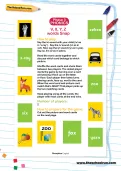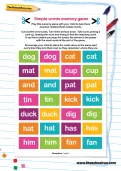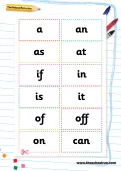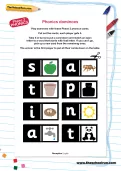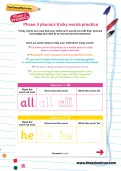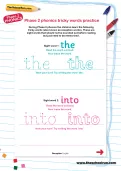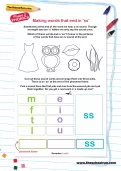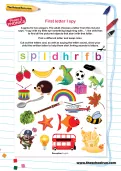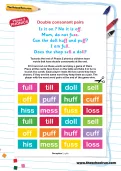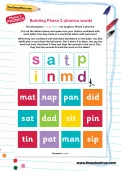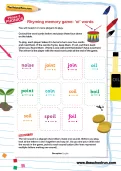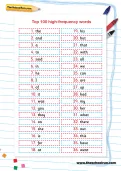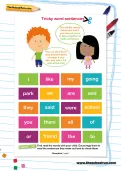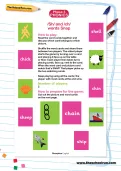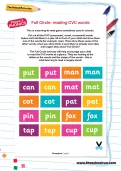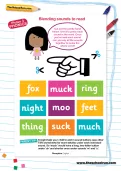Read each of these sentences and then draw a picture that describes what the sentence says.
or
Register to add to your saved resources
Already a subscriber? to view this content.
Play dominoes with these Phase 2 phonics cards. The winner is the first player to put all their cards down on the table
or
Register to add to your saved resources
Already a subscriber? to view this content.
Tricky words are ones that your child can’t sound out with their phonics knowledge but need to be learned and remembered. Here are some ideas to help your child learn tricky words.
or
Register to add to your saved resources
Already a subscriber? to view this content.
These are sight words that should not be sounded out before reading but just need to be memorised. Read the word out loud, then trace the word and finally try writing the word.
or
Register to add to your saved resources
Already a subscriber? to view this content.
Play a game of pairs with these ‘z’ and ‘qu’ words. Each player takes it in turn to pick up two words and read them out. If they find the same word, that is a pair and they get to keep them. The winner is the player with most pairs
or
Register to add to your saved resources
Already a subscriber? to view this content.
Which of these words end in ‘ss’? Colour in the pictures of the words that have an /s/ sound at the end.
or
Register to add to your saved resources
Already a subscriber? to view this content.
The adult chooses a letter from this list and says: “I spy with my little eye something beginning with...”; the child has to find all the pictured objects that start with that letter. Then pick a different letter and swap roles.
or
Register to add to your saved resources
Already a subscriber? to view this content.
Print and cut out these words with double consonants and play a game of Pairs.
or
Register to add to your saved resources
Already a subscriber? to view this content.
Cut out the letters below. Can you think of a word that starts with each one? Now listen to these words – can you hear the sounds in the word? Can you find the sounds to build the word?
or
Register to add to your saved resources
Already a subscriber? to view this content.
Play this fun memory game and see how many 'oi' words you know.
or
Register to add to your saved resources
Already a subscriber? to view this content.
Children learn to read and spell high-frequency words, the most common words in English-language texts, throughout primary school. Download a list of the first 100 high-frequency words to use for at-home spelling practice and revision.
or
Register to add to your saved resources
Shuffle the word cards and share them between two players. The oldest player starts the game by turning over a card and placing it face up on the table or floor. Each player then takes turns placing cards, face up, next to the card. When the word card and picture card match that’s SNAP! The player with most cards at the end wins.
or
Register to add to your saved resources
Cut out the words and see if you can put some of them together to make sentences. You can stick them onto another sheet of paper if you like, and add a full stop at the end.
or
Register to add to your saved resources
Already a subscriber? to view this content.
A free word game created by a teacher for Reception children to help them learn simple, common words for their age group.
or
Register to add to your saved resources
A free Phase 3 phonics game created by an experienced teacher to help your child practise their Phase 3 phonics learning. This printable activity covers /Sh/ and /Ch/ words in a simple game of Snap.
or
Register to add to your saved resources
Spelling isn’t usually tested in Reception, but your child might really like the idea of doing a ‘grown-up spelling test’ (especially if they’ve seen an older sibling prepare for spelling tests!).
or
Register to add to your saved resources
Already a subscriber? to view this content.
This is a learning-to-read game sometimes used in schools. Cut out all the CVC (consonant, vowel, consonant) words and hold them in a pile. Sit in front of your child and show them one of the words (for example, man). Then show them some of the other words; when you show them a word they’ve already seen (like man) again they shout ‘Full Circle’! The Full Circle exercise will help encourage your child to read the CVC words at a glance. They are looking at the letters in the words and the shape of the words – this is what learning to read is largely about!
or
Register to add to your saved resources
Already a subscriber? to view this content.
Cut out the pointy hand and use it to press each sound in the word. Once you’ve said each sound can you say all the sounds together to make the whole word?
or
Register to add to your saved resources
Here is a sound train! Do you remember all the sounds on it? Take a sound from each carriage and write a word!
or
Register to add to your saved resources
Already a subscriber? to view this content.
You’re the teacher! Harry is a child in your class. He has written some of these words correctly. But a few of his word endings are wrong! Put a tick next to the words he’s got correct. Write what the ending should be next to the words Harry has got wrong.
or
Register to add to your saved resources
Already a subscriber? to view this content.
